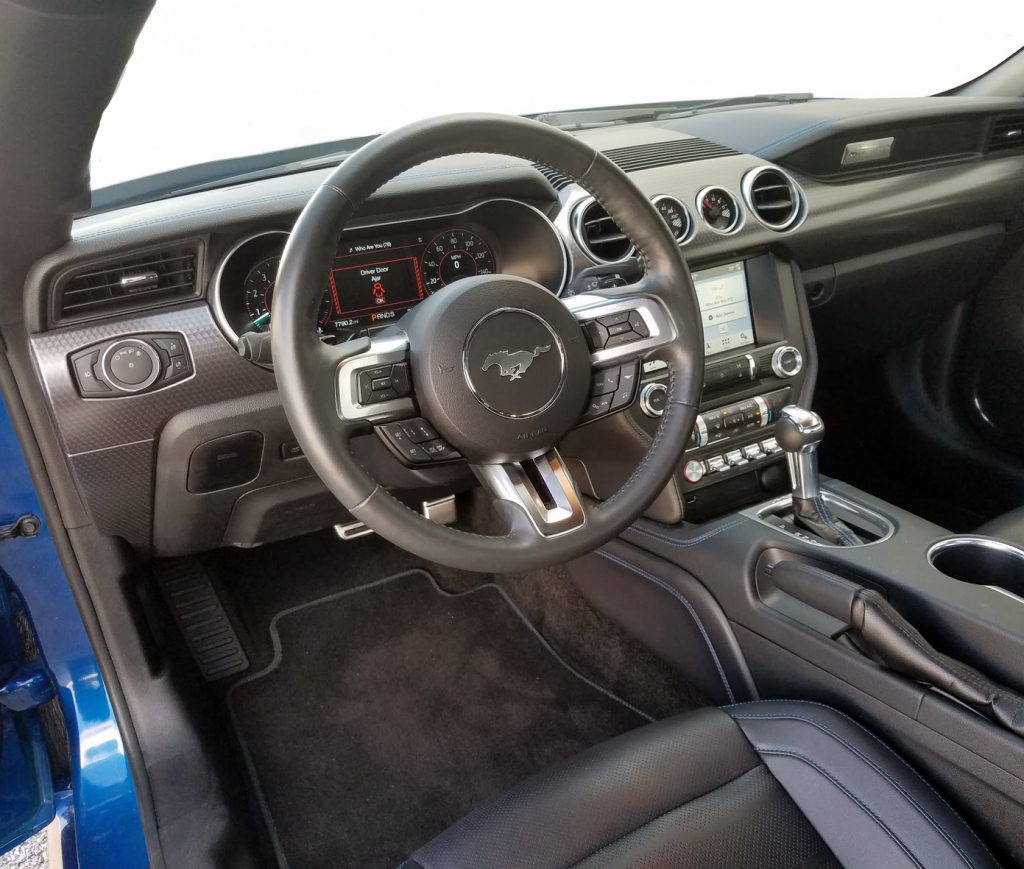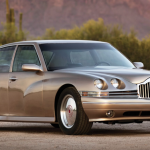
2018 Ford Mustang GT Premium
Class: Sporty/Performance Car
Miles driven: 210
Fuel used: 13.5 gallons
Real-world fuel economy: 15.3 mpg
Driving mix: 65% city, 35% highway
EPA-estimated fuel economy: 16/25/19 (city, highway, combined)
Fuel type: Premium gas recommended
| CG Report Card | |
|---|---|
| Room and Comfort | B |
| Power and Performance | A |
| Fit and Finish | B |
| Fuel Economy | D+ |
| Value | C+ |
| Report-card grades are derived from a consensus of test-driver evaluations. All grades are versus other vehicles in the same class. Value grade is for specific trim level evaluated, and may not reflect Consumer Guide's impressions of the entire model lineup. | |
| Big & Tall Comfort | |
| Big Guy | B- |
| Tall Guy | B- |
| Big & Tall comfort ratings are for front seats only. "Big" rating based on male tester weighing approximately 350 pounds, "Tall" rating based on 6'6"-tall male tester. | |
Base price: $39,095 (not including $900 destination charge)
Options on test vehicle: Equipment Group 401A ($2200), 10-speed automatic transmission ($1595), Safe and Smart Package ($1495), active performance exhaust system ($895), Shaker Pro premium audio system ($895), GT Performance Package ($3995), Magne-Ride damping system ($1695)
Price as tested: $52,765
Quick Hits
The great: Muscle-car power and attitude; alert, smooth-shifting 10-speed automatic transmission
The good: Decent interior room for a sporty coupe
The not so good: Fuel economy, prices get steep as options are added
More Mustang price and availability information
CG Says:
It used to be that anybody who made serious use of a sports car or other high-performance vehicle wouldn’t be caught dead without a manual transmission. Well, used to be is a long time ago now, and the selective-gear transmission stands in an ever-narrowing spotlight on the automotive stage, even in sports machinery. Thanks in large part to leaps in electronics technology, automatics are now quick-acting and more efficient than they’ve ever been, delivering faster track times and better potential fuel economy than concurrent manuals.

There’s always been an automatic transmission available for Ford’s genre-birthing Mustang “ponycar,” but it’s a long way from the 3-speed Cruise-O-Matic of 1965 to the 10-speed autobox that is new to the lineup for 2018. Consumer Guide followed up its test of a 6-speed-manual ’18 Mustang GT with a week in a Lightning Blue Metallic GT with the optional automatic.

As GTs, both test cars were powered by a 5.0-liter V8 of 460 horsepower at 7000 rpm (when burning 93-octane gasoline) and 420 lb-ft of torque at 4600 rpm. Those figures represent increases of 25 horsepower and 20 lb-ft from 2017. The 5.0 is home to a deep well of power that comes on quickly and keeps paying it out in pleasingly linear fashion.
The 10-speed automatic is the product of something that would once have come about only under the coldest conditions imaginable: a collaboration with General Motors. Indeed, the same transmission can be found nestled in the chassis of the Mustang’s longtime rival, the Chevrolet Camaro. In “Normal” drive mode at part throttle—typical for around-town driving—upshifts happen in the Mustang GT around 1700 to 2000 rpm; in “Sport+” mode they hit about 500-700 rpm later to extract additional power from each gear range. Shift force changes from slightly perceptible in Normal to crisper with a bit of a kick in Sport+, and with the optional active-valve performance exhaust doing the voiceover work, the switchover ramps the note up from Normal’s gargle to Sport’s growl and distinct barks as downshifts happen during braking or coasting periods. The engine’s generous midrange torque provides no-doubt highway passing after the trans briskly kicks down two or three gears. Note that additional specialized drive modes labeled “Track,” “Drag Strip,” and “Wet/Snow” are also included.
Test Drive: 2017 Chevrolet Camaro 1LE V6
On paper, the 10-speed automatic helps the Mustang GT get better fuel economy than it could with the manual—by an additional mile per gallon in both city and combined driving, according to EPA figures. However, that’s all pretty academic at a projected 16 mpg in city use, 25 mpg on the highway, and 19 combined. Indeed, CG testers didn’t do that well, logging a collective 15.3 mpg with 65 percent of their driving under city-type conditions. The best single performance was 15.52 mpg. A fuel miser the GT isn’t.
There was one other key difference between the two GT test cars and that was trim level. The automatic job was a Premium coupe with a starting price of $39,995 delivered, which is $4000 more than Ford charges for the “base” GT. The extra money buys additional soft-touch material that shows up on the door tops and centers. Seats are upholstered in leather, and the front buckets are heated and cooled. Ambient lighting, aluminum pedal faces, and illuminated doorsill plates are other interior upgrades, and the external power mirrors are heated and incorporate “pony” projection lamps. Premium-level comfort and convenience items include dual-zone automatic climate control, a 9-speaker audio system with satellite radio, Sync 3 infotainment interface, universal garage-door opener, and the selectable drive modes.
Test Drive: 2018 Ford Mustang GT with Performance Pack 2

The option-packed test car shot up to a considerable $52,765 with the $1595 automatic transmission, active-valve exhaust, GT Performance Package (Ebony Black 19-inch alloy wheels, staggered-width performance tires, decklid spoiler, and 3.55:1-ratio limited-slip rear axle), and “Magne-Ride” adaptive damping upping the car’s performance capabilities. Other add-ons—singly or in groups—introduced interior accent-color stitching, navigation, adaptive cruise control, blind-spot and rear cross-traffic alerts, and 12-speaker audio.
The Midnight Blue bucket seats in the test car were the standard design with 6-way power adjusters and a power lumbar setting for the driver’s seat. They are less confining than the grippier optional Recaro sport seats that were in our stickshift GT test car, but one tester felt the standard seats lacked sufficient support and preferred the sport seats even though they don’t have power controls.
In other respects, a GT is a GT, regardless of transmission or trim, with a firm ride, well-controlled handling, generally uncomplicated infotainment and climate controls, good-for-a-sports-coupe driver sightlines, and rear seats far better suited for expanding the modest cargo capacity than they are for welcoming additional passengers.
Ford Is Killing Off Its Sedans. Here’s What That Means…





